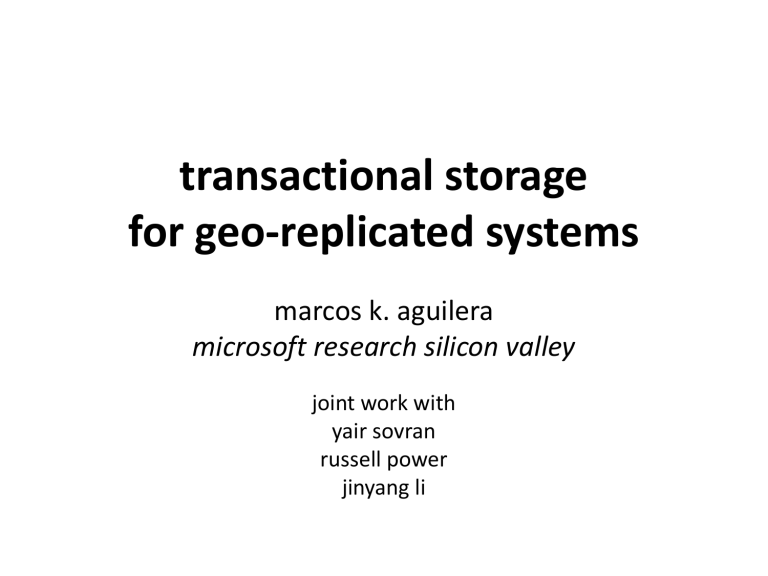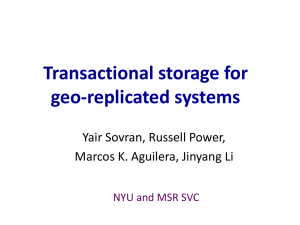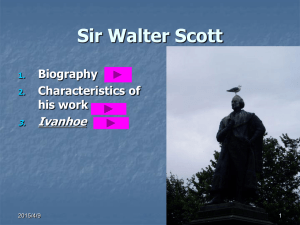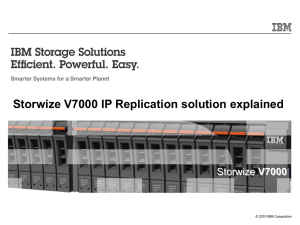walter

transactional storage for geo-replicated systems
marcos k. aguilera microsoft research silicon valley joint work with yair sovran russell power jinyang li
one slide summary
• walter is a key-value store for web apps, featuring transactions data replication across distant sites (geo-replication)
• transactional semantics: parallel snapshot isolation (PSI) property is strong, yet it has efficient implementation
• implementation of PSI uses two techniques preferred sites counting sets
• using walter, we built two geo-replicated apps facebook-like app, twitter-like app
motivation
• web applications growing in size
– social networks, web mail, messaging
• beyond a single data center or site
– more capacity: world-wide user base
– access locality: web users get local service
– disaster tolerance: if site fails others can take over
• goal: infrastructure for developing apps deployed on many sites
architecture of a web application
• shared persistent state only at bottom tier
• higher tiers have only private session state or no state
• to deploy at many sites, replicate picture at each site
• hard part, which our work concerns: storage tier
– state possibly shared among users
existing solutions for storage tier
• replicated database systems
– single-master: updates must be done at one server
– multi-master: application must resolve conflicts
– hard and expensive to scale
• highly-scalable storage (Google, Amazon, HP, etc)
– either single site systems
[SDDS, BigTable, GFS, Sinfonia, Percolator]
– or limited or no support for transactions
[PNUTS, Cassandra]
– or poor multi-site performance
[Megastore]
walter: multi-site storage system
• geo-replication = replication across sites
• transactions (next slide)
• non-structural choice
– interface based on key-value pairs write(key,value) read(key)
– terminology: object = key-value pair
why transactions in storage system?
• help dealing with hard problems arising from concurrency+failures
• transfer hard problems from application to storage infrastructure
– fewer storage systems than applications
– infrastructure developers have better expertise
why transactions, part two: life without transactions
• issue of integrity of the storage state
– dangling references
– orphan objects
– unexpected reference cycles
– garbage
• resulting in
– code complexity
– lack of productivity
– loss of software quality
• our goal in providing transactions: facilitate job of web developer without sacrificing performance
transaction coordination and anomalies
less coordination, more anomalies snapshot isolation serializability parallel snapshot isolation (PSI) eventual consistency
snapshot isolation
• supported by commercial DB systems
• properties
– reads performed on a consistent snapshot
– writes concentrated at commit time
– no write-write conflicts
issue with snapshot isolation
• it orders the commit time of all transactions even those that do not conflict with each other
• forbids some scenarios we want to allow for efficiency
issue with snapshot isolation (cont’d)
• scenario forbidden by snapshot isolation
(it requires total ordering of update transactions)
Alice initial state
Bob initial state
A2. read see own transaction photo
(see own update)
A3. read transaction
B2. read transaction
B3. read transaction
parallel snapshot isolation (PSI)
snapshot isolation
• one commit time
• one timeline
• read from snapshot
• no write-write conflicts
PSI
• a commit time per site
• a timeline per site
• read from snapshot at site
• ditto
• causality property
parallel snapshot isolation (PSI)
features
(1) commit time per site, (2) timeline per site,
(3) read from snapshot at site, (4) no write-write conflicts
(5) causality: if T1 commits at site S before T2 starts at site S then
T2 does not commit before T1 at any site
implementing PSI efficiently
• PSI prohibits write-write conflicts (even across sites)
• issue: how to enforce it efficiently?
(without coordination across sites)
• two techniques
– preferred sites: optimize updates at certain sites
– counting sets: data structure that eliminates conflicts
technique #1: preferred sites
• each object assigned a preferred site
• at that site, object can be written efficiently transactions that modify objects at their preferred site can use fast commit (without cross-site communication)
• inspired by notion of a primary site but less restrictive, because objects modifiable at any site
• example of usage: web application preferred site of objects of a user = site close to where user usually logs in from
potential performance issue
• what if many sites often modify an object?
• no good way to assign a preferred site to object
• bad idea: keep changing preferred sites of object
– requires cross site communication
– defeats efficiency goal
technique #2: counting sets
• goal: eliminate conflicts
• when clients update the same object concurrently, most likely they do not want to overwrite it
– otherwise we have a race condition
• cast concurrent updates as operations on a set
– example: users B and C adds themselves to A’s friends list
– instead of writes, treat updates as set additions
• set addition commutes, so conflict eliminated
counting sets (cont’d)
• beyond opaque key-value pairs
– value in key-value pair treated as a set
• primitive operations in transactions
– not just reads, writes, but also set operations
– transaction manager understands some updates are commutative so they do not conflict
• want: all set operations to commute with each other
– so no need to check for conflicts at all
– but set operations are not always commutative
counting sets: anti-elements
• example of non-commutative operations
– Alice: add x to set S
– Bob: remove x from set S
– different execution order = different outcome
• goal: make all operations commutative
• counting set = map from id to counter (negative values ok)
– add: increment counter remove: decrement counter
– removing from empty set: set with “anti-element”
• increment and decrement always commute, so no conflicts
putting both techniques together
• certain transactions: fast execution and commit
= without cross site communication
– if preferred site of written objects is local or
– updates done on counting sets objects
• other transactions: slow commit
= with cross site communication
walter API
start(): void
commit(): int
abort(): int
read(oid, buffer): int
write(oid, buffer, length): int
setAdd(csetoid, id): int
setDel(csetoid, id): int
setRead(csetoid, iterator): int
C++ example
Tx x;
x.start();
len = x.read(o1, &buf);
err = x.write(o2, buf, len);
res = x.commit();
PHP example
$x = waStartTx();
$buf = waRead($x, $o1);
$err = waWrite($x, $o2, $buf);
$res = waCommit($x);
walter architecture
scalability
• walter server can be scalability bottleneck on site
• solutions
1. smaller sites, many per data center data center 1 data center 2
2. distribute walter server replace commit with distributed commit
partial replication
• objects need not be replicated at all sites replica set chosen by administrator
• application can access any object even if not locally replicated system gives illusion all objects replicated at all sites system retrieves appropriate version from remote site
• useful for large state (e.g., user’s emails)
using walter: applications
1. built waltSocial
– social networking application
– runs on many sites
2. ported reTwis to run on many sites
– existing twitter clone written in PHP
– original uses redis key-value store (single site)
– replaced redis with walter
waltSocial
• simple social networking application
• supports common operations, such as
– befriend
– post message on wall
– read info
• uses counting sets
– friends list, message list
• preferred site
– site close to user
– where user logs into
/* befriend operation */
Tx x;
x.start();
x.read(oidA, &profileA);
x.read(oidB, &profileB);
x.setAdd(profileA.friendlist, oidB);
x.setAdd(profileB.friendlist, oidA);
success = x.commit();
reTwis
• twitter clone
• uses redis key-value store
– supports atomic operations on lists, counters
– works on a single site (*)
(*) redis supports replication across sites, but it is limited to a master-slave scheme
• we replaced redis with walter
– to support multi-site operation
– atomic operations replaced with transactions
– uses counting set to store timeline
• port done in less than a day
evaluation
• used Amazon EC2 with four sites
Virginia (VA), California (CA), Ireland (IE), Singapore (SG) round-trip latency from 82ms (VA-CA) to 277ms (IE-SG)
• some experiments on local cluster, because
– EC2 performance was poor with many threads
– EC2 has write caching at the disks
• experiments evaluate
– performance of walter
– performance of applications of walter
walter performance, one site
• base performance on one site
• done on local cluster not EC2 walter berkeley db read transactions write transactions
72 Ktps 34 Ktps
80 Ktps 32 Ktps
• in EC2, performance is halved
walter performance, many sites write workload on EC2, full replication
walter performance, many sites read workload on EC2, full replication
waltSocial performance
on 4 sites in EC2, full replication operation read info befriend post message
# objects accessed throughput
3 40 Kops/s
4
6
20 Kops/s
17 Kops/s
reTwis performance
in EC2
related work
• commutative replicated types inspired counting sets, but proposed types different
• cloud storage systems single-site only: Bigtable, Sinfonia, Percolator, distributed b-tree no or limited transactions: Dynamo, PNUTS, COPS multi-site, synchronous replication: Megastore
• database systems literature replication: provides serializability or snapshot isolation=slow escrow transactions: for numeric data, slow
• eventual consistency requires conflict resolution logic
conclusion
• web apps increasingly deployed over many sites
• developers need appropriate storage infrastructure
• transactions are a powerful abstraction
• can provide transactions with reasonable performance semantics: parallel snapshot isolation
• techniques
– preferred sites
– counting sets
one slide summary
• walter is a key-value store for web apps, featuring transactions data replication across distant sites (geo-replication)
• transactional semantics: parallel snapshot isolation (PSI) property is strong, yet it has efficient implementation
• implementation of PSI uses two techniques preferred sites counting sets
• using walter, we built two geo-replicated apps facebook-like app, twitter-like app
backup slides
containers
• an object has metadata
– replica set: where it is replicated
– preferred site
• too wasteful to keep metadata per object
• objects are grouped into containers
• objects in a container share metadata
preferred versus primary sites
• definition-wise: primary is more restrictive
– preferred allows writes at any site
• context-wise: also more restrictive
– use many primary-backup databases
– transactions cannot cross databases
– or semantics unclear
anomalies
PSI Anomaly short fork long fork conflicting fork dirty read non-repeatable read lost update
Serializ
-ability
No
No
No
No
No
No
Snapshot
Isolation
Yes
No
No
No
No
No
Yes
Yes
No
No
No
No
Eventual
Consistency
Yes
Yes
Yes
Yes
Yes
Yes long fork short fork (write skew)
using PSI
• multi-object atomic updates
– all writes in transaction happen together
• snapshots
– reads come from snapshot of data
• read-modify-write operations
– transactions read object and writes updated version
• conditional writes
– transaction reads object, checks condition, and modify object only if condition holds
– can check and write many objects at once
• others?











